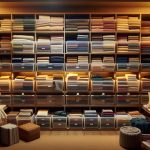When it comes to storing fabrics, you need to take into account more than just folding and packing them away. Different materials require specific conditions to preserve their integrity over time. You wouldn't want your delicate silks to get musty or your woolens to be attacked by moths, right? Choosing the right storage solutions, like breathable containers and proper folding techniques, can make a significant difference. But that's just the beginning. How can you make sure your fabrics stay fresh, organized, and ready for use whenever you need them? Let's explore the essential steps to keep your textiles in top condition.
Table of Contents
Key Takeaways
- Store fabrics in breathable, acid-free containers to prevent damage and yellowing.
- Use vacuum sealing for cottons and synthetics to save space and deter pests.
- Fold fabrics along natural lines and use acid-free tissue paper to avoid creases.
- Monitor humidity with a hygrometer and use silica gel packs to control moisture.
- Categorize and label storage containers by fabric type for easy organization and access.
Choosing the Right Storage
When selecting the appropriate storage for your fabrics, take into account both the material type and the environmental conditions. Different fabrics require specific storage methods to maintain their quality. To illustrate, delicate silks and wools need breathable storage containers to avoid moisture buildup, while cottons and synthetics can benefit from vacuum sealing to save space and protect against pests.
Efficient closet organization is crucial to keeping your fabric collection accessible and in good condition. Utilize transparent storage containers to easily identify your fabrics without searching through heaps. Label each container with the fabric type and yardage for swift reference. For frequently used fabrics, contemplate adjustable shelving solutions. Shelves allow you to stack folded fabrics neatly while keeping them visible and within reach.
Furthermore, consider the environmental conditions of your storage area. Fabrics should be stored in a cool, dry place away from direct sunlight, which can lead to fading. If you're arranging a closet, make sure it's well-ventilated to prevent mold and mildew.
Proper storage not only maintains the quality of your fabrics but also enhances your sewing projects' enjoyment by keeping everything organized and ready to use.
Folding Techniques
When it comes to folding fabrics, you need to focus on avoiding creases effectively.
Proper folding techniques will help you utilize space efficiently while preserving the quality of your fabrics.
Let's explore how you can achieve this with a few simple methods.
Avoiding Creases Effectively
To evade creases effectively, master the art of folding fabrics with these simple techniques. Start by using proper ironing methods to guarantee your fabric is smooth before folding. A well-ironed piece noticeably reduces the chances of creases forming during storage.
Once ironed, fold your fabric in a manner that minimizes pressure points. For delicate fabrics, consider loosely rolling them instead of folding to prevent sharp creases.
Choose your storage containers wisely. Opt for breathable fabric bins or acid-free boxes to maintain fabric quality and prevent any moisture buildup that could lead to creases. Avoid overstuffing containers; give each piece enough space to breathe.
If storage space allows, explore hanging solutions for fabrics prone to creasing, such as silks or linens. Hanging your fabrics can alleviate pressure points and keep them crease-free. For heavier materials, use padded hangers to maintain their shape.
Occasionally, fabrics may develop creases despite your best efforts. For fabric restorations, lightly mist the creased area with water and gently stretch the fabric before ironing again.
Mastering these folding techniques and storage strategies will keep your fabrics looking flawless and ready for use.
Optimal Space Utilization
Maximize your storage space by mastering efficient folding techniques tailored to different fabric types. Start by folding lightweight fabrics, like cotton and linen, in neat squares or rectangles, making them easy to stack in storage containers.
For heavier fabrics, such as wool or denim, roll them tightly to prevent wrinkles and save space. This method is especially useful for closet organization, as it allows you to see all your fabrics at a glance.
For delicate fabrics, consider vacuum sealing. This technique compresses the fabric, reducing its volume and protecting it from moisture and pests. Simply fold the fabric neatly, place it in a vacuum-seal bag, and use a vacuum to remove the air. This method is ideal for long-term storage or when space is at a premium.
If you prefer hanging solutions, use padded hangers for delicate materials to prevent stretching. For heavier fabrics, use sturdy wooden or plastic hangers. Group similar fabrics together for easy access and a streamlined look in your closet.
Preserving Fabric Quality
Proper folding techniques are crucial for preserving the quality of your fabrics and safeguarding they remain in excellent condition over time. Start by folding each piece of fabric along its natural lines to avoid unnecessary creases.
For delicate fabrics, place acid-free tissue paper between folds to prevent fiber breakdown.
Consider vacuum sealing for long-term storage, which minimizes exposure to air and moisture. If vacuum sealing isn't an option, use breathable garment bags to keep your fabrics protected while allowing some air circulation. Garment bags are particularly useful for larger pieces like quilts or vintage garments.
To further preserve fabric quality, store them in a cool, dry place. Add cedar blocks instead of mothballs; they naturally repel pests without the harsh chemicals that can damage fibers. Cedar blocks also impart a pleasant scent, enhancing your storage environment. However, if you must use mothballs, place them in a breathable pouch to mitigate direct contact with the fabric.
Lastly, rotate stored fabrics periodically to prevent permanent creasing and guarantee even exposure to environmental conditions.
Protecting From Light
Guarding your fabrics from direct sunlight is crucial to prevent fading and deterioration. Light exposure can lead to colors fading and weakening the fabric fibers, causing your beloved textiles to appear worn and dull. To maintain their vibrancy, keep fabrics away from windows and any direct light sources. Instead, store them in dark closets or drawers where sunlight can't reach them.
Implementing UV protection is also a key preservation technique. Choose window treatments like UV-blocking shades or curtains to shield your fabrics from harmful rays. You can even find UV-protective storage containers that provide an additional layer of defense. When displaying fabrics, consider using UV-filtering glass for frames or cases.
For added protection, rotate your fabric collection periodically. This simple practice ensures that no single piece suffers prolonged light exposure, thereby minimizing the risk of color fading. Additionally, using acid-free tissue paper to wrap your fabrics can further safeguard them from indirect light and dust.
Controlling Humidity
To keep your fabrics in pristine condition, controlling the humidity levels in their storage environment is vital. Excessive moisture can lead to mold, mildew, and fabric degradation, so maintaining ideal conditions is necessary.
Here's how you can master humidity and moisture control for your fabric collection:
- Use a Hygrometer: Regularly monitor the humidity levels in your storage space. Aim for a humidity range between 30-50%. Hygrometers are affordable and provide accurate readings.
- Dehumidifier Usage: Invest in a reliable dehumidifier if your storage area tends to be damp. A dehumidifier will help maintain the ideal humidity levels, protecting your fabrics from excessive moisture.
- Proper Ventilation: Make sure your storage area is well-ventilated. Good airflow prevents stagnant air, which can contribute to moisture buildup. Use fans or open windows periodically to enhance air circulation.
- Silica Gel Packs: Place silica gel packs in your fabric storage containers. These packs absorb excess moisture, providing an additional layer of protection against humidity.
Organizing by Type
Sorting your textiles by type makes it simpler to locate what you require and helps maintain their quality. To master this, begin by categorizing fabrics based on their material, such as cotton, silk, or wool. This sorting technique guarantees that delicate fabrics, like silk, aren't harmed by heavier materials like denim.
Next, consider color coordination within each group. Grouping similar colors together not only creates an aesthetically pleasing storage area but also prevents color bleeding. For example, store all your dark-hued cotton fabrics in one section and your light-hued ones in another. This enables you to easily find the precise shade you need without searching through stacks.
Utilize transparent, labeled containers or drawers for each fabric type and color category. This method enhances an additional level of organization and makes your assortment easily accessible.
If you have a substantial amount, fabric bolts or rolls can be neatly arranged on shelves, categorized by type and color. By applying these sorting techniques, you'll streamline your crafting process and uphold the quality of your fabrics, guaranteeing they remain in prime condition for upcoming projects.
Long-Term Storage Tips
When storing fabrics for the long term, make sure they're clean and dry to prevent mold and mildew. Proper preparation ensures your textiles remain in top condition. Here are some expert tips to follow:
- Vacuum Sealing: Use vacuum sealing to remove air from fabric storage bags. This method not only saves space but also protects against moisture and pests. Just be cautious with delicate fabrics, as the compression can damage them.
- Garment Bags: For more delicate or heirloom fabrics, opt for breathable garment bags. These bags prevent dust buildup while allowing airflow, which is essential for materials that need to avoid moisture accumulation.
- Acid-Free Tissue Paper: Wrap your fabrics in acid-free tissue paper before placing them in storage. This prevents yellowing and minimizes creases. Acidic materials can degrade fabric over time, so always use archival-quality materials for wrapping.
- Climate Control: Store fabrics in a climate-controlled environment. Avoid basements and attics where temperature and humidity levels fluctuate. Aim for a consistent, cool, and dry space to keep your fabrics in pristine condition.
Frequently Asked Questions
How Do I Remove Musty Odors From Stored Fabrics?
Oh, you've discovered the joys of musty fabric smells? Delightful! For odor removal, employ baking soda or vinegar. As for fabric storage solutions, guarantee proper ventilation. Prevention's better: follow fabric care tips to avoid future mustiness.
Can I Store Fabrics in Vacuum-Sealed Bags?
Absolutely, you can store fabrics in vacuum-sealed bags. This method enhances fabric preservation by protecting against moisture and pests. For best storage solutions, make sure fabrics are clean and dry before sealing to prevent damage.
Is It Safe to Store Fabrics in Plastic Bins?
Oh indeed, because who doesn't want their fabrics to breathe? Storing fabrics in plastic bins is fine for fabric care if you guarantee moisture prevention. Just don't forget to open them once in a while!
What Should I Do if Fabrics Develop Mold or Mildew?
If your fabrics develop mold or mildew, immediately take them outside to prevent spreading. For mildew removal, wash with hot water and vinegar. For mold prevention and fabric care, guarantee thorough drying before using airtight storage solutions.
How Often Should I Check on Stored Fabrics for Signs of Damage?
You should monitor stored fabrics every few months. Regular fabric storage rotation and fabric storage temperature monitoring help prevent damage. This proactive approach guarantees you catch any issues early and maintain your fabrics in top condition.
- Tetron Fabric for Marine Applications: Durability and Use Cases - June 18, 2025
- Tetron Fabric for Outdoor Furniture: Weather Resistance and Care - June 18, 2025
- Tetron Fabric for Wall Coverings: Style and Application Tips - June 18, 2025





